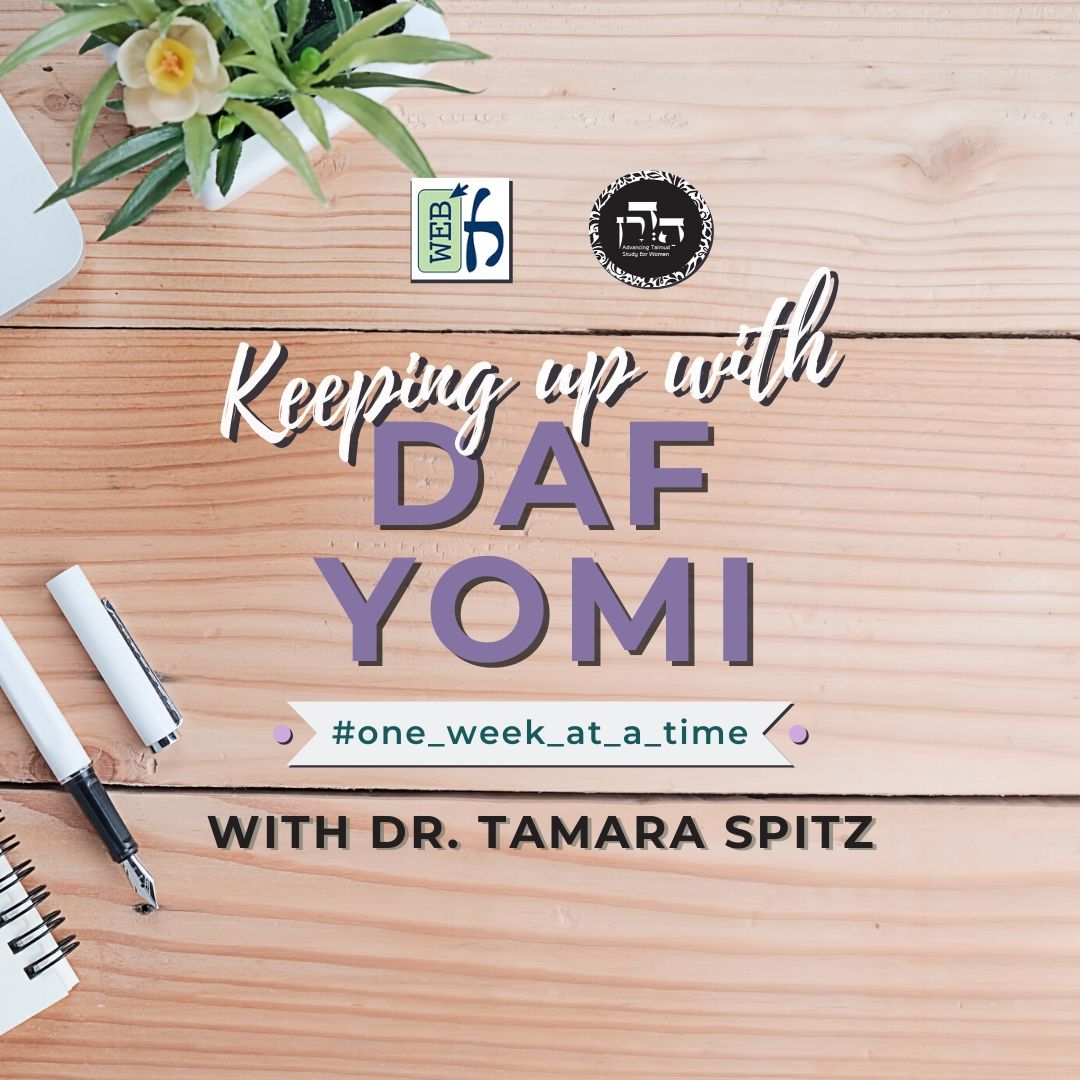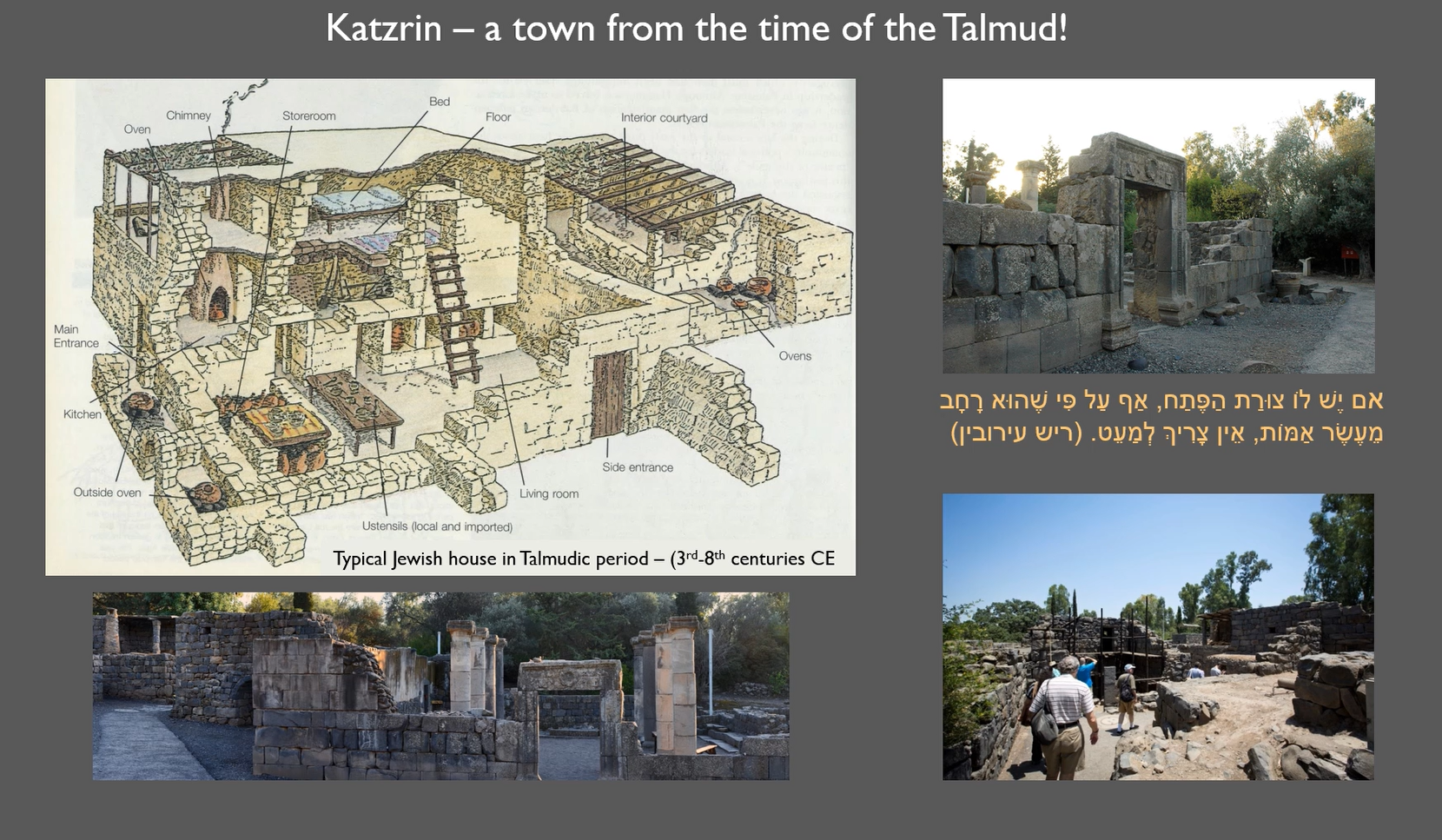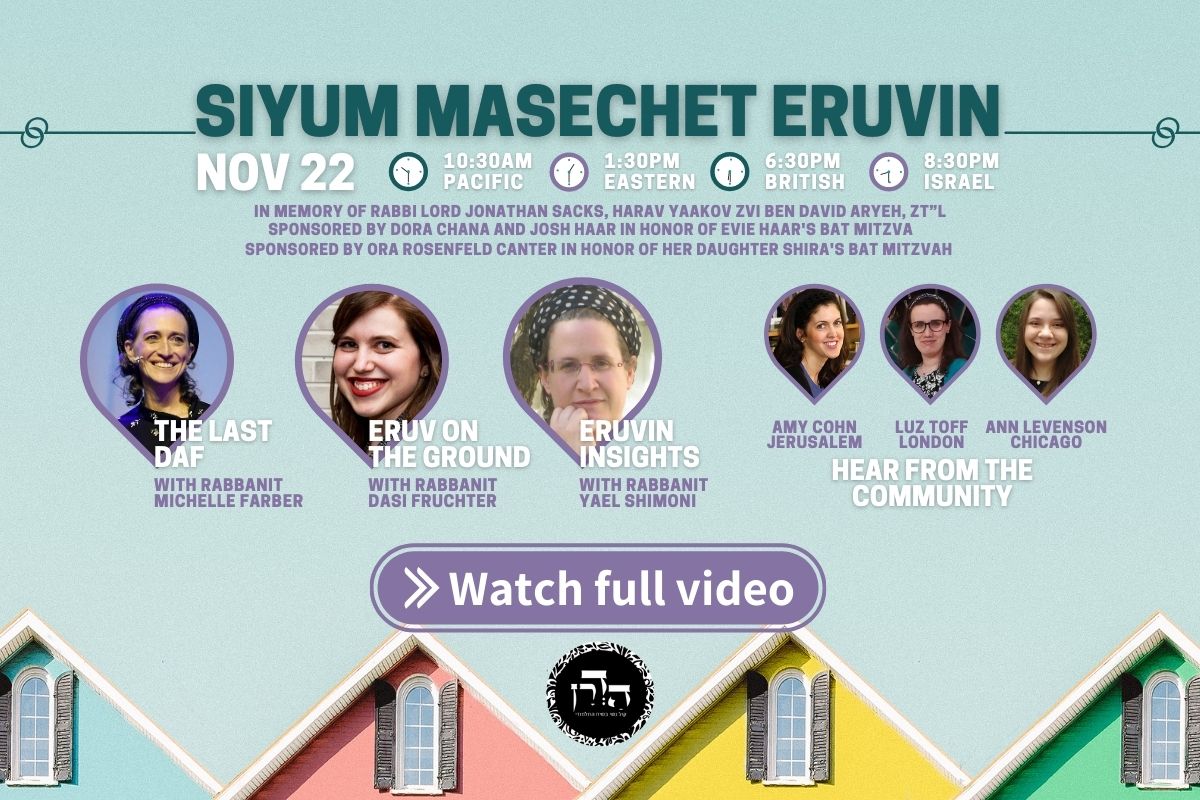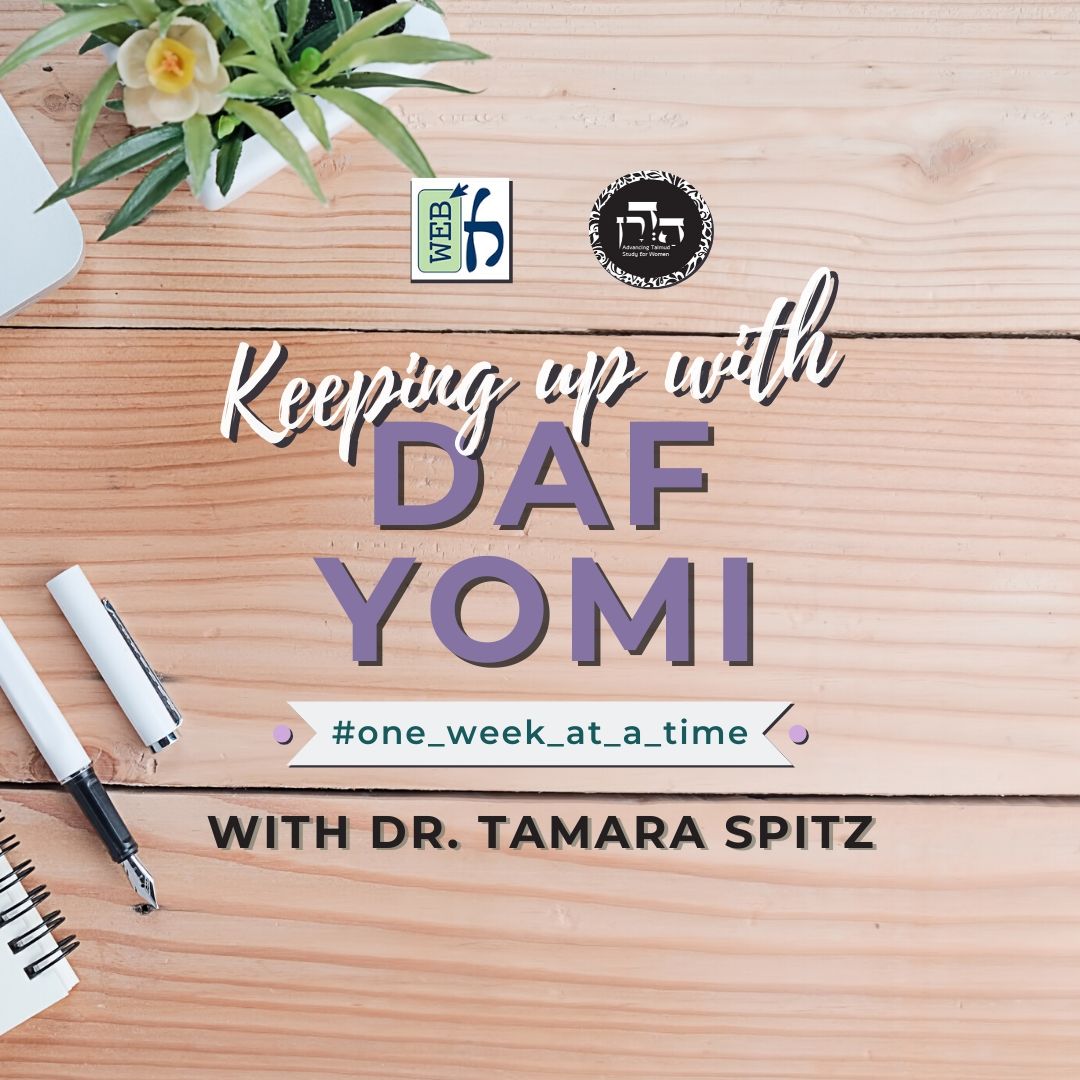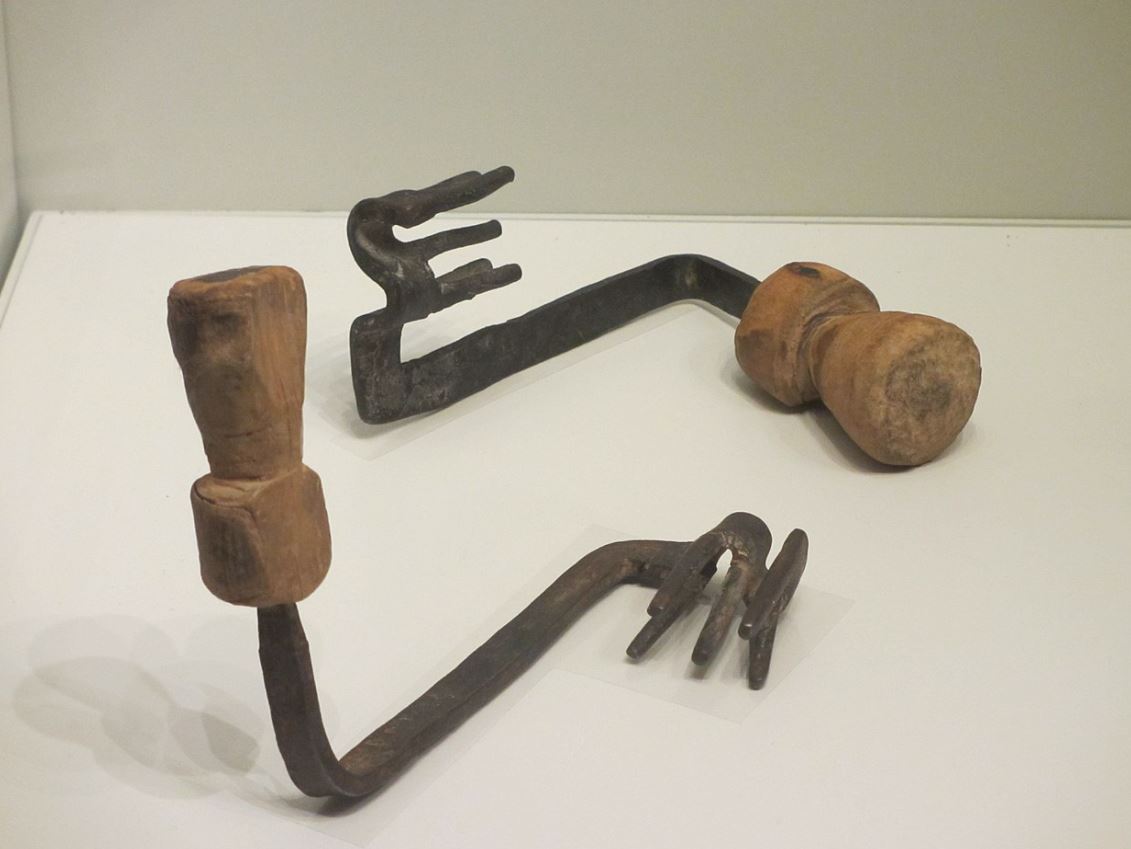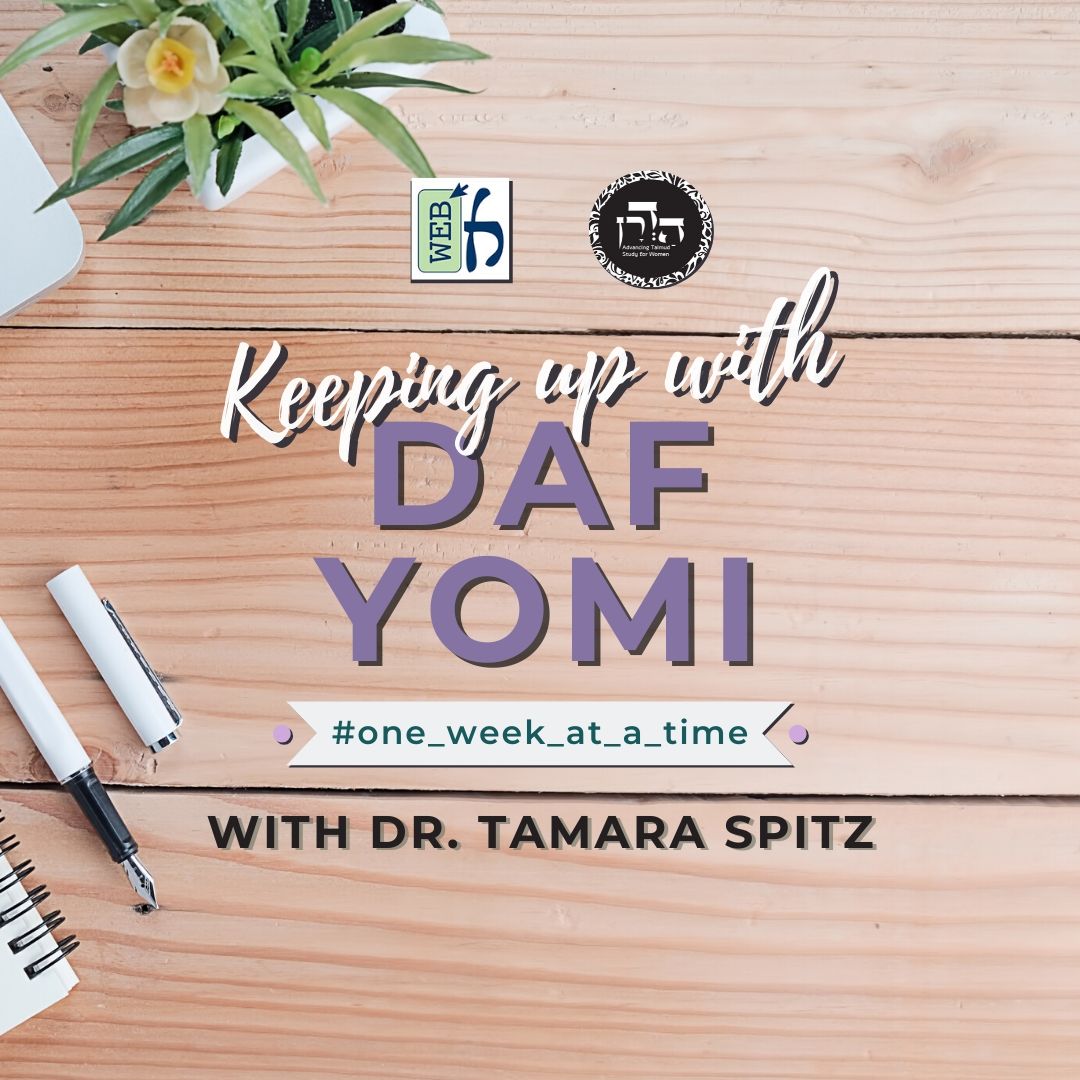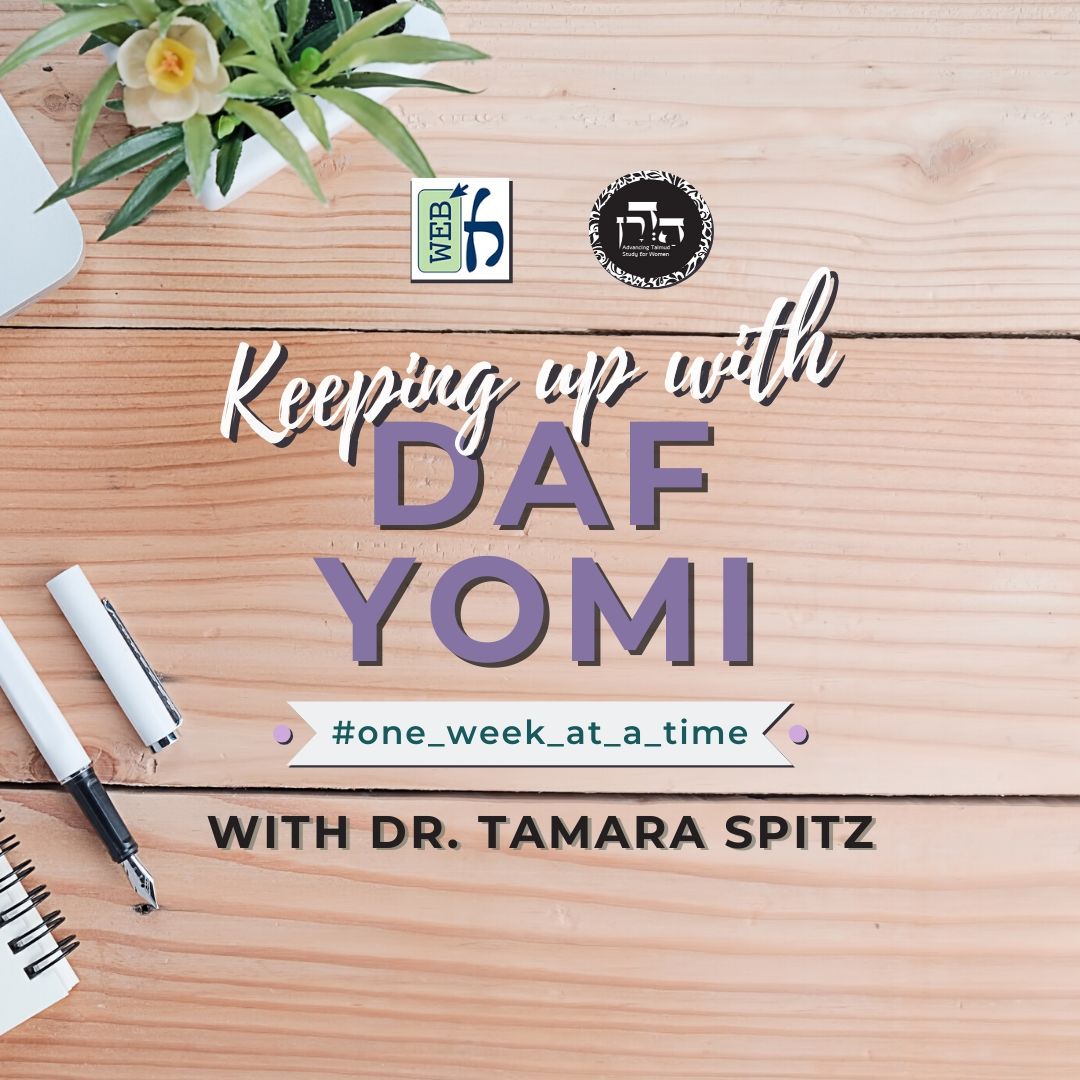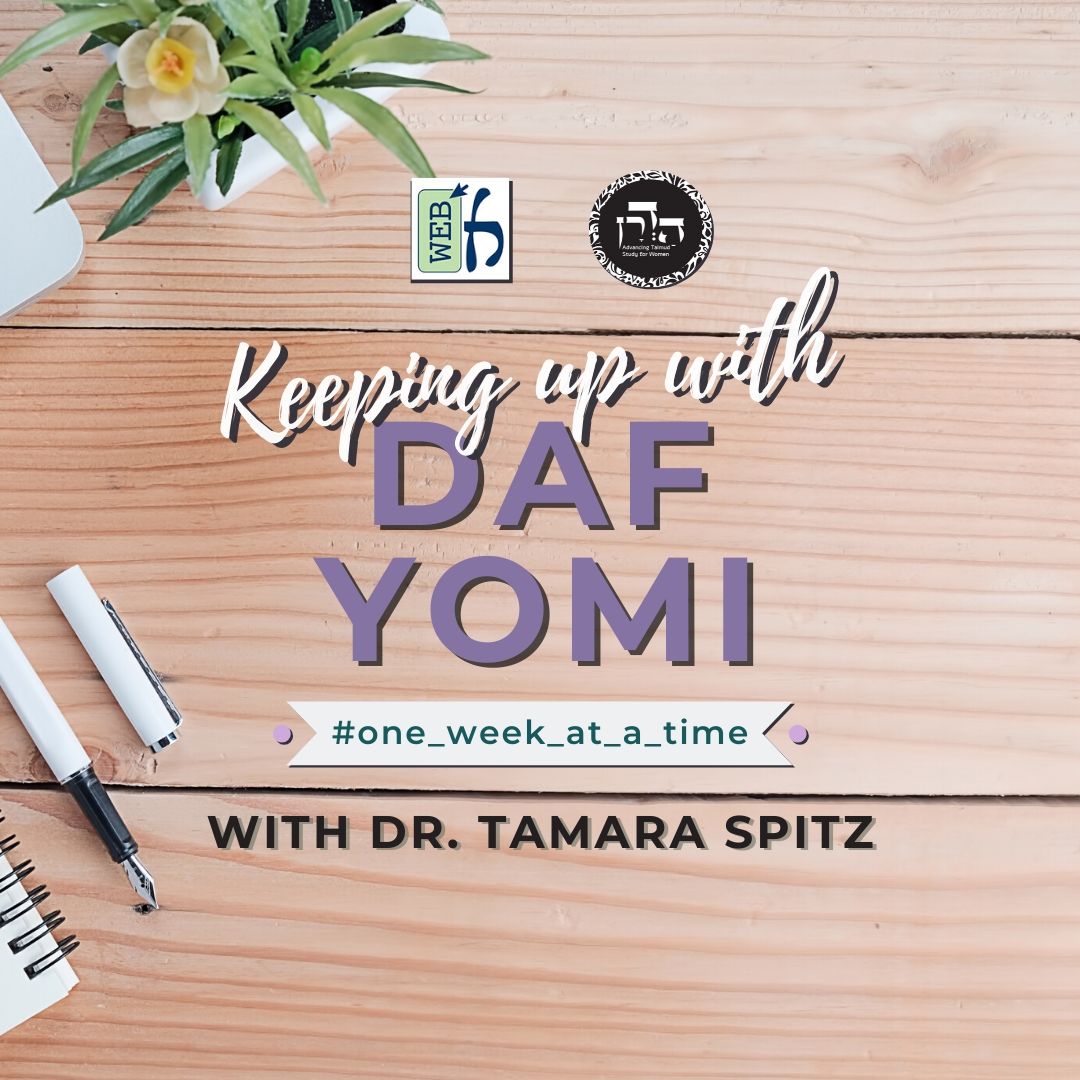Eruvin 88
Share this shiur:
Want to dedicate learning? Get started here:


Summary
Today’s daily daf tools:
Today’s daily daf tools:
Delve Deeper
Broaden your understanding of the topics on this daf with classes and podcasts from top women Talmud scholars.
New to Talmud?
Check out our resources designed to help you navigate a page of Talmud – and study at the pace, level and style that fits you.
The Hadran Women’s Tapestry
Meet the diverse women learning Gemara at Hadran and hear their stories.
Eruvin 88
אַנְשֵׁי טְבֶרְיָא כְּמִי שֶׁלֹּא יִבְטַל מִמְּלַאכְתּוֹ דָּמֵי.
the inhabitants of Tiberias are considered like one who does so in order not to neglect his usual work. Most of them are ordinary laborers. It can be assumed that if they rose early to bring home straw or stalks in which to store their produce, they did so only to save work time.
וּמִסְתַּפְּגִין בַּאֲלוּנְטִית מַאי הִיא, דְּתַנְיָא: מִסְתַּפֵּג אָדָם בַּאֲלוּנְטִית, וּמַנִּיחָהּ בַּחַלּוֹן. וְלֹא יִמְסְרֶנָּה לָאוֹלְיָירִין מִפְּנֵי שֶׁחֲשׁוּדִין עַל אוֹתוֹ דָּבָר. רַבִּי שִׁמְעוֹן אוֹמֵר: אַף מְבִיאָהּ בְּיָדוֹ לְתוֹךְ בֵּיתוֹ.
The Gemara turns to the third activity that Rabbi Ḥananya ben Akavya permitted for the inhabitants of Tiberias: And they may dry themselves with a towel. What is this halakha? As it was taught in a baraita: A person who washed himself in cold water on Shabbat or a Festival may dry himself with a towel and place it on a window, as there is no concern that he perform the prohibited labor of wringing out the towel. And he may not give the towel to the bathhouse attendants [olayerin] because they are suspected with regard to that matter, as they might wring out the towel before giving it to other bathers. Furthermore, one may not bring the towel home because if he does so, he might forget and wring it out. Rabbi Shimon said: He may even bring the towel in his hand to his house, as there is no concern lest he wring it.
אָמַר רַבָּה בַּר רַב הוּנָא: לֹא שָׁנוּ אֶלָּא לְמַלּאוֹת, אֲבָל לִשְׁפּוֹךְ — אָסוּר.
Rabba bar Rav Huna: They taught the leniency of partitions surrounding a hole in a balcony only with regard to drawing water through the hole; but to pour waste water down the hole, it is prohibited.
מַתְקֵיף לַהּ רַב שֵׁיזְבִי: וְכִי מָה בֵּין זֶה לְעוּקָה?
Rav Sheizvi raised an objection against this halakha: And what is the difference between this case of a hole in the balcony and that of a pit [uka] used in a courtyard for waste water? The Sages rule in the next mishna below that one who digs a pit with a capacity of two se’a in a small courtyard that is less than four cubits may pour waste water into the courtyard on Shabbat, even if the pit was full before Shabbat. He need not be concerned that this will cause water to flow out of the courtyard into the public domain on Shabbat.
הָנֵי תָּיְימִי, וְהָנֵי לָא תָּיְימִי.
The Gemara answers: These waters, which are poured out into the courtyard, are likely to be absorbed into the ground, and it is therefore uncertain that the water will indeed leave the courtyard. But these, the water poured through the hole into the body of water under the balcony, will not be absorbed. Therefore, one knows with certainty that the water will flow out beyond the permitted boundary.
אִיכָּא דְּאָמְרִי, אָמַר רַבָּה בַּר רַב הוּנָא: לָא תֵּימָא לְמַלּאוֹת הוּא דִּשְׁרֵי, לִשְׁפּוֹךְ אָסוּר, אֶלָּא לִשְׁפּוֹךְ נָמֵי שְׁרֵי. אָמַר רַב שֵׁיזְבִי: פְּשִׁיטָא — הַיְינוּ עוּקָה! מַהוּ דְּתֵימָא: הָנֵי תָּיְימִי וְהָנֵי לָא תָּיְימִי, קָא מַשְׁמַע לַן.
Some say that Rabba bar Rav Huna actually said: You should not say that it is only drawing water through the hole in the balcony that is permitted, while pouring waste water through it is prohibited; rather, pouring waste water through the hole is also permitted. Rav Sheizvi said: This is obvious, as this is exactly the same as the halakha of the pit discussed in the next mishna. The Gemara rejects this argument: It is necessary to specify both halakhot, lest you say there is a difference between the cases, as these, the water poured in the courtyard, are likely to be absorbed into the ground, whereas these, the water poured through the hole in the balcony, will not be absorbed. Rabba bar Rav Huna therefore teaches us that we do not distinguish between the two cases.
וְכֵן שְׁתֵּי גְזוּזְטְרָאוֹת זוֹ וְכוּ׳. אָמַר רַב הוּנָא אָמַר רַב: לֹא שָׁנוּ אֶלָּא בִּסְמוּכָה, אֲבָל בְּמוּפְלֶגֶת — עֶלְיוֹנָה מוּתֶּרֶת.
We learned in the mishna: And likewise, if there are two balconies, one above the other, and a partition is erected for the upper balcony but is not erected for the lower one, it is prohibited for residents of both balconies to draw water through the upper one, unless they establish a joint eiruv between them. Rav Huna said that Rav said: They taught that one balcony renders it prohibited for residents of the other only where the one balcony is near the other, i.e., horizontally within four handbreadths. But if each balcony is separated by four handbreadths from the other, so that the residents of each balcony can use the other only by means of the air, the residents of the upper balcony are permitted to draw water, while the residents of the lower one are prohibited from doing so.
וְרַב לְטַעְמֵיהּ, דַּאֲמַר רַב: אֵין אָדָם אוֹסֵר עַל חֲבֵירוֹ דֶּרֶךְ אֲוִיר.
And Rav follows his regular line of argument here, as Rav said: One person does not impose restrictions upon another person by way of the air. Since the lower balcony is far from the higher one, it does not prohibit it, although it can make use of it by means of the vacant airspace between them, albeit with difficulty.
אָמַר רַבָּה אָמַר רַבִּי חִיָּיא, וְרַב יוֹסֵף אָמַר רַבִּי אוֹשַׁעְיָא: יֵשׁ גָּזֵל בְּשַׁבָּת. וְחוּרְבָּה מַחֲזִיר לַבְּעָלִים.
Rabba said that Rabbi Ḥiyya said, and Rav Yosef said that Rabbi Oshaya said: The halakha of stealing applies to Shabbat domains, and a ruin must be returned to its owner.
הָא גוּפָא קַשְׁיָא: אָמְרַתְּ ״יֵשׁ גָּזֵל בְּשַׁבָּת״ — אַלְמָא קָנְיָא, ״וְחוּרְבָּה מַחֲזִיר לִבְעָלִים״ — אַלְמָא לָא קָנְיָא!
The Gemara registers surprise: This ruling itself is difficult, i.e., it is self-contradictory. You first said that the halakha of stealing applies to Shabbat domains, which at this point is understood by the Gemara as referring to the following case: A person’s house adjoins the ruin of another, and he observes that the ruin has been left deserted by its owner. If this person uses the ruin during the week, on Shabbat he may treat it as though it were his own, by carrying objects from his own house into the ruin and vice versa. From here we can infer that a stolen place is acquired for the purpose of Shabbat domains, although it does not belong to the person for other purposes. However, you subsequently said that a ruin must be returned to its owner, and from here we can infer that a ruin is not acquired for the purpose of Shabbat domains by the person who used it during the week, and therefore he may not carry objects from his own house into the ruin.
הָכִי קָאָמַר: יֵשׁ דִּין גָּזֵל בְּשַׁבָּת, כֵּיצַד — דְּחוּרְבָּה מַחֲזִיר לַבְּעָלִים.
The Gemara answers: We should not understand this statement as suggested above, but rather this is what Rabbi Ḥiyya and Rabbi Oshaya are saying: The halakha of returning stolen property applies to Shabbat domains. How so? This means that a ruin must be returned to its owner. In other words, one who uses a ruin during the week does not acquire it even for the purpose of Shabbat domains.
אָמַר רַבָּה, וּמוֹתְבִינַן אַשְּׁמַעְתִּין: וְכֵן שְׁתֵּי גְזוּזְטְרָאוֹת זוֹ לְמַעְלָה מִזּוֹ וְכוּ׳. וְאִי אָמְרַתְּ יֵשׁ דִּין גָּזֵל בְּשַׁבָּת, אַמַּאי אֲסוּרוֹת?
Rabba said: And we ourselves raised an objection against our own teaching, as we learned in the mishna. And likewise, if there are two balconies, one above the other, they prohibit one another. But if you say that the halakha against stealing applies on Shabbat, which means one may not use the domain of another, and he acquires no rights to it if he does so, why are the two balconies prohibited from using it. The lower one has no right to make use of the upper one.
אָמַר רַב שֵׁשֶׁת: הָכָא בְּמַאי עָסְקִינַן, כְּגוֹן שֶׁעָשׂוּ מְחִיצָה בְּשׁוּתָּפוּת.
Rav Sheshet said: We are dealing here with a situation where, for example, the residents of the upper balcony and the residents of the lower balcony jointly erected a partition for the upper balcony. Consequently, the residents of the lower balcony share the right to use it with the residents of the upper one.
אִי הָכִי, כִּי עָשׂוּ לַתַּחְתּוֹנָה נָמֵי!
The Gemara raises a difficulty: If so, in a case where they erected a separate partition for the lower balcony, the residents of the upper balcony should likewise be prohibited to use it. As the residents of the lower one are partners in the upper one, they should prohibit its residents from using it.
כֵּיוָן דְּעָשׂוּ לַתַּחְתּוֹנָה — גַּלּוֹיֵי גַּלִּי דַּעְתַּהּ דַּאֲנָא בַּהֲדָךְ לָא נִיחָא לִי.
The Gemara answers: Since they erected a separate partition for the lower balcony, they each thereby revealed their intention to the residents of the upper balcony that: It is not my wish to be partners with you. Consequently, they no longer prohibit the residents of the upper balcony from using it.
מַתְנִי׳ חָצֵר שֶׁהִיא פְּחוּתָה מֵאַרְבַּע אַמּוֹת — אֵין שׁוֹפְכִין בְּתוֹכָהּ מַיִם בְּשַׁבָּת, אֶלָּא אִם כֵּן עָשׂוּ לָהּ עוּקָה מַחְזֶקֶת סָאתַיִם מִן הַנֶּקֶב וּלְמַטָּה.
MISHNA: With regard to a courtyard that is less than four cubits by four cubits in area, one may not pour waste water into it on Shabbat, unless a pit was fashioned to receive the water, and the pit holds two se’a in volume from its edge below.
בֵּין מִבַּחוּץ, בֵּין מִבִּפְנִים. אֶלָּא שֶׁמִּבַּחוּץ — צָרִיךְ לִקְמוֹר, מִבִּפְנִים — אֵין צָרִיךְ לִקְמוֹר.
This halakha applies whether the pit was fashioned outside the courtyard or whether it was dug inside the courtyard itself. The only difference is as follows: If the pit was dug outside in the adjoining public domain, it is necessary to arch over it, so that the water will not flow into the public domain. If it was dug inside the courtyard, it is not necessary to arch over it.
רַבִּי אֱלִיעֶזֶר בֶּן יַעֲקֹב אוֹמֵר: בִּיב שֶׁהוּא קָמוּר אַרְבַּע אַמּוֹת בִּרְשׁוּת הָרַבִּים — שׁוֹפְכִים לְתוֹכוֹ מַיִם בַּשַּׁבָּת. וַחֲכָמִים אוֹמְרִים: אֲפִילּוּ גַּג אוֹ חָצֵר מֵאָה אַמָּה — לֹא יִשְׁפּוֹךְ עַל פִּי הַבִּיב, אֲבָל שׁוֹפֵךְ הוּא לַגַּג, וְהַמַּיִם יוֹרְדִין לַבִּיב.
Rabbi Eliezer ben Ya’akov says: In the case of a drainage ditch whose first four cubits are arched over in the public domain, one may pour waste water into it on Shabbat. And the Rabbis say: Even if a roof or a courtyard is a hundred cubits in area, one may not pour water directly onto the mouth of the drainage ditch. However, he may pour it upon the roof, from which the water spills into the drain of its own accord.
הֶחָצֵר וְהָאַכְסַדְרָה מִצְטָרְפִין לְאַרְבַּע אַמּוֹת. וְכֵן שְׁתֵּי דְיוֹטָאוֹת זוֹ כְּנֶגֶד זוֹ, מִקְצָתָן עָשׂוּ עוּקָה וּמִקְצָתָן לֹא עָשׂוּ עוּקָה, אֶת שֶׁעָשׂוּ עוּקָה — מוּתָּרִין, אֶת שֶׁלֹּא עָשׂוּ עוּקָה — אֲסוּרִין.
A courtyard and a portico, a roofed but unwalled structure in front of a house, combine for the four cubits by virtue of which it is permitted to pour water even into a courtyard that lacks a pit. And likewise, with regard to two upper stories [deyotaot], one opposite the other in the same small courtyard, if the residents of one of them fashioned a pit in the courtyard, and the residents of the other did not fashion a pit, those who fashioned a pit are permitted to pour their waste water into the courtyard, whereas those who did not fashion a pit are prohibited to do so.
גְּמָ׳ מַאי טַעְמָא? אָמַר רַבָּה: מִפְּנֵי שֶׁאָדָם עָשׂוּי לְהִסְתַּפֵּק סָאתַיִם מַיִם בְּכׇל יוֹם, בְּאַרְבַּע אַמּוֹת — אָדָם רוֹצֶה לְזַלְּפָן,
GEMARA: The Gemara asks: What is the reason that a courtyard four by four cubits in area does not require a pit? Rabba said: Because a person ordinarily uses two se’a of water a day, and with regard to a courtyard of at least four cubits by four cubits, a person wants to sprinkle the water on the ground to prevent any dust from rising. Consequently, even if in practice the water does flow out of the courtyard, this effect is not necessarily his intention.
פָּחוֹת מֵאַרְבַּע — שׁוֹפְכָן. אִי דַּעֲבִיד עוּקָה — שְׁרֵי, אִי לָא — אָסוּר.
But if the courtyard is less than four cubits by four cubits in area, one simply pours the water out, as the place is not fit for sprinkling. Therefore, if one fashioned a pit, it is permitted to pour out water; but if not, it is prohibited to do so, as one certainly intends for the water to flow outside.
רַבִּי זֵירָא אָמַר: אַרְבַּע אַמּוֹת — תָּיְימִי, פָּחוֹת מֵאַרְבַּע אַמּוֹת — לָא תָּיְימִי.
Rabbi Zeira offered a different reason and said: In a courtyard of four cubits by four cubits, the water is likely to be absorbed into the ground. If it is less than four cubits in size, the water will not be absorbed but will flow out.
מַאי בֵּינַיְיהוּ? אָמַר אַבָּיֵי: אֲרִיךְ וְקַטִּין אִיכָּא בֵּינַיְיהוּ.
The Gemara asks: What is the practical difference between these two explanations? Abaye said: There is a difference between them with regard to a long and narrow courtyard. As the area of this courtyard is also sixteen square cubits, it likewise absorbs the water. Rabbi Zeira would therefore rule that it does not require a pit. However, as this courtyard is not in need of sprinkling, it requires a pit according to Rabba.
תְּנַן: חָצֵר וְאַכְסַדְרָה מִצְטָרְפִין לְאַרְבַּע אַמּוֹת. בִּשְׁלָמָא לְרַבִּי זֵירָא נִיחָא, אֶלָּא לְרַבָּה קַשְׁיָא!
We learned in the mishna: A courtyard and a portico combine for the requisite four cubits, permitted the pouring of water into a courtyard that lacks a pit. The Gemara asks: Granted, according to the opinion of Rabbi Zeira, this works out well, as the total area is large enough to absorb the water. However, according to Rabba it is difficult, for when the courtyard is joined with the portico it is no longer in the shape of a square, and it is therefore unfit for sprinkling.
תַּרְגְּמָא רַבִּי זֵירָא אַלִּיבָּא דְרַבָּה בְּאַכְסַדְרָה מְהַלֶּכֶת עַל פְּנֵי כָּל הֶחָצֵר כּוּלָּהּ.
Rabbi Zeira explained the mishna in accordance with the opinion of Rabba, by saying that it is referring to a portico that extends along the entire courtyard, so that it adds to its width alone. Consequently, the courtyard and the portico together form a square of four by four cubits, an area that is fit for sprinkling.
תָּא שְׁמַע: חָצֵר שֶׁאֵין בָּהּ אַרְבַּע אַמּוֹת עַל אַרְבַּע אַמּוֹת — אֵין שׁוֹפְכִין לְתוֹכָהּ מַיִם בַּשַּׁבָּת. בִּשְׁלָמָא לְרַבָּה נִיחָא, אֶלָּא לְרַבִּי זֵירָא קַשְׁיָא!
The Gemara suggests: Come and hear a baraita that can decide this dispute. With regard to a courtyard that is not four cubits by four cubits in area, one may not pour water into it on Shabbat. The Gemara assumes that the baraita, which teaches that one may pour water only into a courtyard that it is four by four cubits, is precise in its wording. Granted, according to Rabba, this works out well, as he maintains that it is prohibited to pour water into a long and narrow courtyard. However, according to Rabbi Zeira, who maintains that the critical factor is the area of the courtyard, this is difficult.
אָמַר לָךְ רַבִּי זֵירָא: הָא מַנִּי רַבָּנַן הִיא, וּמַתְנִיתִין רַבִּי אֱלִיעֶזֶר בֶּן יַעֲקֹב הִיא.
The Gemara answers that Rabbi Zeira can say to you: In accordance with whose opinion is this baraita? It is in accordance with the opinion of the Rabbis at the end of the mishna, who maintain that the area of the courtyard is of no importance, whereas our unattributed mishna is in accordance with the opinion of Rabbi Eliezer ben Ya’akov, according to whom the area is the decisive factor.
וּמַאי דּוּחְקֵיהּ דְּרַבִּי זֵירָא לְאוֹקֹמַהּ לְמַתְנִיתִין כְּרַבִּי אֱלִיעֶזֶר בֶּן יַעֲקֹב? אָמַר רָבָא: מַתְנִיתִין קְשִׁיתֵיהּ, מַאי אִירְיָא דְּתָנֵי ״חָצֵר שֶׁהִיא פְּחוּתָה״, לִיתְנֵי: ״חָצֵר שֶׁאֵין בָּהּ אַרְבַּע אַמּוֹת עַל אַרְבַּע אַמּוֹת״!
The Gemara asks: And what forced Rabbi Zeira to establish the mishna in accordance with the opinion of Rabbi Eliezer ben Ya’akov? Rava said: The mishna was difficult for him. Why did the tanna specifically teach his ruling with respect to a courtyard that is less than four cubits, from which it can be inferred that if it has an area of four by four cubits it is permitted to pour water, even if it is not square in shape? Let the mishna teach: A courtyard that is not four cubits by four cubits, i.e., one that is not square shaped, even if it includes an area of sixteen square cubits.
אֶלָּא לָאו שְׁמַע מִינַּהּ, דְּרַבִּי אֱלִיעֶזֶר בֶּן יַעֲקֹב הִיא. שְׁמַע מִינַּהּ.
Rather, shouldn’t one conclude from this argument that the unattributed section of the mishna is in accordance with the opinion of Rabbi Eliezer ben Ya’akov? The Gemara summarizes: Indeed, conclude from this that it is so.
וְהָא מִדְּסֵיפָא רַבִּי אֱלִיעֶזֶר בֶּן יַעֲקֹב, רֵישָׁא לָאו רַבִּי אֱלִיעֶזֶר בֶּן יַעֲקֹב!
The Gemara raises a difficulty with this conclusion: But from the fact that a latter clause of the mishna explicitly cites the opinion of Rabbi Eliezer ben Ya’akov, it can be inferred that the first clause does not represent the opinion of Rabbi Eliezer ben Ya’akov.
כּוּלַּהּ רַבִּי אֱלִיעֶזֶר בֶּן יַעֲקֹב הִיא, וְחַסּוֹרֵי מִיחַסְּרָא, וְהָכִי קָתָנֵי: חָצֵר שֶׁהִיא פְּחוּתָה מֵאַרְבַּע אַמּוֹת — אֵין שׁוֹפְכִין לְתוֹכָהּ מַיִם בְּשַׁבָּת, הָא אַרְבַּע אַמּוֹת — שׁוֹפְכִין, שֶׁרַבִּי אֱלִיעֶזֶר בֶּן יַעֲקֹב אוֹמֵר: בִּיב הַקָּמוּר אַרְבַּע אַמּוֹת בִּרְשׁוּת הָרַבִּים — שׁוֹפְכִין לְתוֹכוֹ מַיִם בַּשַּׁבָּת.
The Gemara rejects this argument: In fact, the entire mishna is in accordance with the opinion of Rabbi Eliezer ben Ya’akov, and as for its problematic style, the mishna is incomplete and it teaches the following: With regard to a courtyard that is less than four cubits in area, one may not pour waste water into it on Shabbat. Consequently, if it is four cubits in area, one may pour water into it, as Rabbi Eliezer ben Ya’akov says: If the first four cubits of a drainage ditch were arched over in the public domain, one may pour waste water into it on Shabbat.
רַבִּי אֱלִיעֶזֶר בֶּן יַעֲקֹב אוֹמֵר: בִּיב הַקָּמוּר.
We learned in the mishna that Rabbi Eliezer ben Ya’akov says: If the first four cubits of a drainage ditch were arched over in the public domain, it is permitted to pour waste water into it on Shabbat. However, the Rabbis say: One may pour water only upon the roof, from which it will spill into the drain of its own accord.
מַתְנִיתִין דְּלָא כַּחֲנַנְיָא. דְּתַנְיָא, חֲנַנְיָא אוֹמֵר: אֲפִילּוּ גַּג מֵאָה אַמָּה — לֹא יִשְׁפּוֹךְ, לְפִי שֶׁאֵין הַגָּג עָשׂוּי לִבְלוֹעַ, אֶלָּא לְקַלֵּחַ.
The Gemara comments: The mishna was not taught in accordance with the opinion of Ḥananya. For it was taught in a baraita that Ḥananya says: Even with regard to a roof one hundred cubits in area, one may not pour water onto it, because a roof is not apt to absorb the water. Rather, it causes it to run off. Consequently, pouring water onto this roof is equivalent to pouring it directly outside.
תָּנָא: בַּמֶּה דְּבָרִים אֲמוּרִים — בִּימוֹת הַחַמָּה, אֲבָל בִּימוֹת הַגְּשָׁמִים — שׁוֹפֵךְ וְשׁוֹנֶה וְאֵינוֹ נִמְנָע. מַאי טַעְמָא? אָמַר רָבָא: אָדָם רוֹצֶה שֶׁיִּבָּלְעוּ מַיִם בִּמְקוֹמָן.
A tanna taught: In what case is this statement, that a pit is required, said? In the summer, but in the rainy season, one may pour and repeat, and he need not hold back. What is the reason? Rava said: A person is equally willing for the water to be absorbed on the spot, i.e., as there is abundant water in the courtyard during the rainy season, it will remain muddy in any case, and he therefore does not care whether the added waste water remains in the courtyard or if it flows out.
אֲמַר לֵיהּ אַבָּיֵי: וַהֲרֵי שׁוֹפְכִין, דְּאָדָם רוֹצֶה שֶׁיִּבָּלְעוּ, וְקָתָנֵי ״לֹא יִשְׁפּוֹךְ״!
Abaye said to him: With regard to waste water poured into a drainage ditch, that a person wants it to be absorbed in the ditch itself, rather than flow out, and yet the mishna teaches that one may not pour water into the ditch.
אֲמַר לֵיהּ: הָתָם לְמַאי נֵיחוּשׁ לַהּ, אִי מִשּׁוּם קִלְקוּל חֲצֵירוֹ — הָא מִיקַּלְקְלָא וְקָיְימָא. וְאִי מִשּׁוּם גְּזֵירָה שֶׁמָּא יֹאמְרוּ ״צִנּוֹרוֹ שֶׁל פְּלוֹנִי מְקַלֵּחַ מַיִם״ — סְתָם צִנּוֹרוֹת מְקַלְּחִים הֵם.
Rava said to him: There, during the rainy season, there is no reason to prohibit the practice, for with regard to what need we be concerned? If you say he wants the water to flow out into the public domain because he is concerned about spoiling and sullying his courtyard, it is already spoiled by the rainwater. And if you say it should be prohibited due to a decree lest people say that so-and-so’s gutter is flowing with water on Shabbat, which might lead them to think he is watering his garden or violating some other prohibition, and they might act likewise even in the summer, this is not a relevant concern. As gutters ordinarily flow with water in the rainy season, people do not entertain this suspicion.
אָמַר רַב נַחְמָן: בִּימוֹת הַגְּשָׁמִים, עוּקָה מַחֲזִיק סָאתַיִם — נוֹתְנִין לוֹ סָאתַיִם, מַחֲזִיק סְאָה — נוֹתְנִין לוֹ סְאָה. בִּימוֹת הַחַמָּה, מַחֲזִיק סָאתַיִם — נוֹתְנִין לוֹ סָאתַיִם, סְאָה — אֵין נוֹתְנִין לוֹ כָּל עִיקָּר.
Rav Naḥman said: In the rainy season, with regard to a pit that holds two se’a, we grant him permission to pour two se’a of water into it. If it holds only one se’a, we grant him one se’a. However, in the summer, if the pit has a capacity of two se’a, we grant him two se’a; if it holds only one se’a, we do not grant him permission to pour any water at all.
בִּימוֹת הַחַמָּה נָמֵי, מַחֲזִיק סְאָה נִיתֵּיב לֵיהּ סְאָה! גְּזֵרָה דִּלְמָא אָתֵי לִיתֵּן לֵיהּ סָאתַיִם. אִי הָכִי בִּימוֹת הַגְּשָׁמִים נָמֵי לִיגְזוֹר!
The Gemara raises a difficulty: In the hot season as well, if the pit holds one se’a, let us grant him one se’a, for if he pours only this amount of water, it will not flow out into the public domain. The Gemara answers: This is prohibited due to a decree lest he come to put two se’a into it. The Gemara asks: If so, in the rainy season let us also apply the same preventive measure.
הָתָם מַאי נֵיחוּשׁ לַהּ? אִי מִשּׁוּם קִילְקוּל — הָא מִיקַּלְקְלָא וְקָיְימָא. אִי מִשּׁוּם גְּזֵירָה ״שֶׁמָּא יֹאמְרוּ צִנּוֹרוֹ שֶׁל פְּלוֹנִי מְקַלֵּחַ מַיִם״ — סְתָם צִנּוֹרוֹת מְקַלְּחִין הֵן.
The Gemara answers: There, in the rainy season, there is no reason to prohibit the practice, for if one pours more water into a pit than it can take, about what need we be concerned? If you say he wants the waste water to flow out into the public domain because he is concerned about spoiling his courtyard, it is already spoiled by the rainwater. If you say it should be prohibited due to a decree lest people say that so-and-so’s gutter is flowing with water on Shabbat, gutters ordinarily gush with water in the rainy season, as stated above.
אָמַר אַבָּיֵי: הִילְכָּךְ, אֲפִילּוּ כּוֹר וַאֲפִילּוּ כּוֹרַיִים.
Abaye said: Therefore, in accordance with this reasoning, one can pour even a kor and even two kor of waste water into a small pit. As all gutters flow with water in the rainy season, there is no cause for any concern.
וְכֵן שְׁתֵּי דְיוֹטָאוֹת זוֹ כְּנֶגֶד זוֹ. אָמַר רָבָא: אֲפִילּוּ עֵירְבוּ.
We learned in the mishna: And likewise, with regard to two upper stories, one opposite the other in the same courtyard, the residents of the one who dug a pit in the courtyard may pour water into it, while the residents of the other one who did not dig a pit in the courtyard are prohibited from doing so. Rava said: This halakha applies even if the residents of the two upper stories established an eiruv together.
אֲמַר (לֵיהּ) אַבָּיֵי: מַאי טַעְמָא? אִילֵּימָא מִשּׁוּם נְפִישָׁא דְמַיָּא, וְהָתַנְיָא: אַחַת לִי עוּקָה, וְאַחַת לִי גִּיסְטְרָא בְּרֵיכָה וַעֲרֵיבָה, אַף עַל פִּי שֶׁנִּתְמַלְּאוּ מַיִם מֵעֶרֶב שַׁבָּת — שׁוֹפְכִין לְתוֹכָן מַיִם בַּשַּׁבָּת!
Abaye said to him: What is the reason for this ruling? If you say it is due to the increase in the amount of water, as two upper stories pour out more water than one, wasn’t it taught in a baraita: The same halakha applies to a pit, and the same applies to a cracked earthenware vessel used as a receptacle for water, or a small pond, or a basin: Even though they were already filled with water on Shabbat eve, one may pour water into them on Shabbat. It is evident from here that as long as the pit is the requisite size, there is no concern about the amount of water that will flow out from it.
אֶלָּא, אִי אִיתְּמַר, הָכִי אִיתְּמַר: אָמַר רָבָא
Rather, if it was stated it was stated as follows. Rava said:


